Training and Development Program Report: Marriott Hospitality Sector
VerifiedAdded on 2021/05/30
|14
|4162
|74
Report
AI Summary
This report provides a comprehensive analysis of a training and development program designed for Marriott, a leading hospitality company. The report begins by emphasizing the critical importance of training within organizations, especially in the hospitality sector, and highlights the potential negative consequences of inadequate training. It then describes the organization, identifies the target participants, and explains how both participants and the organization benefit from the program. A detailed program plan is presented, including objectives, a schedule of activities, and the method of delivery, which incorporates on-the-job and web-based training. The report also outlines instructions for the trainer, feedback mechanisms, and required resources. Finally, it addresses potential barriers to implementation and offers insights into management support, perception, participation, finance, and conflicting priorities. The report aims to improve employee skills and enhance the overall structure and productivity of the company.
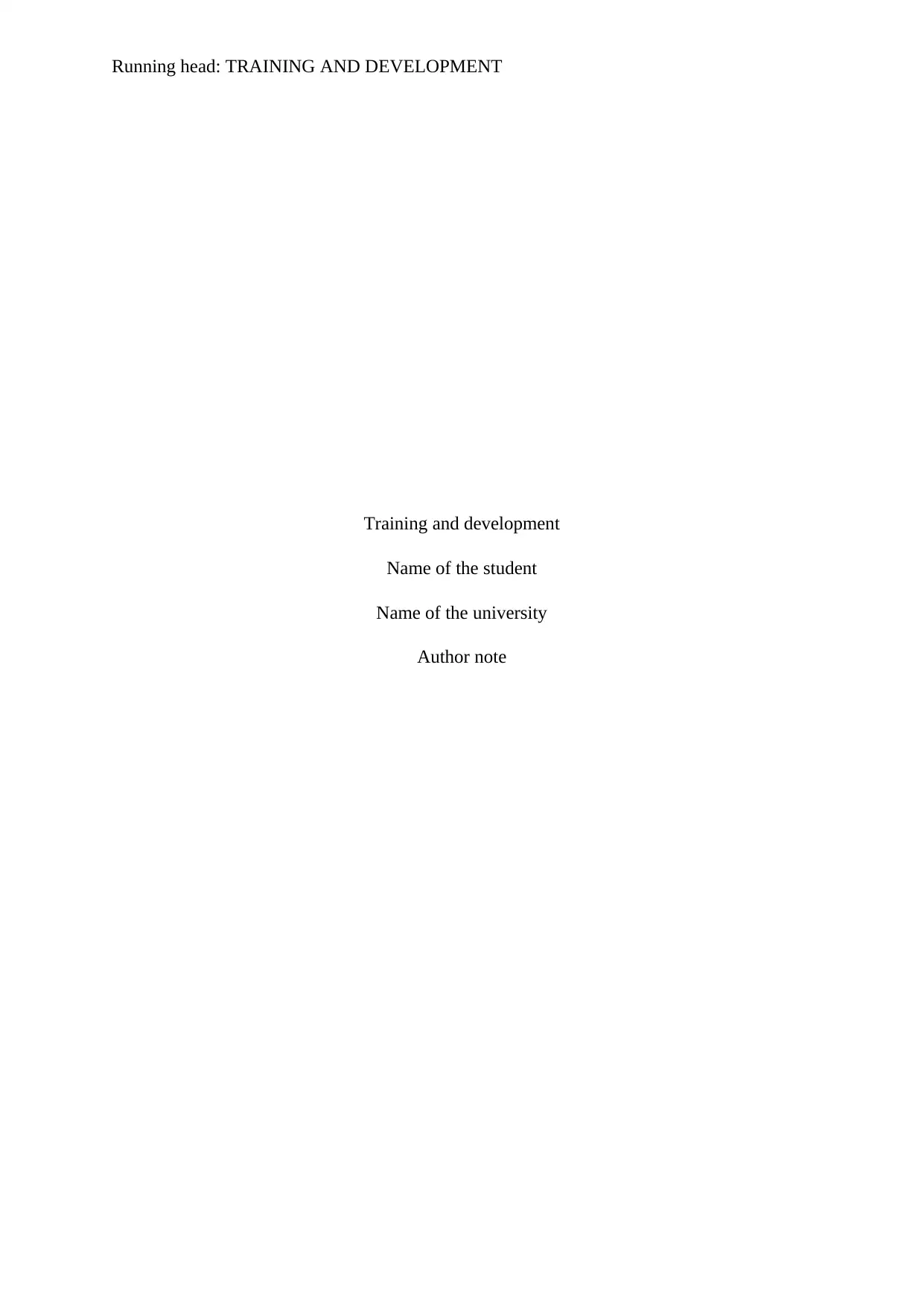
Running head: TRAINING AND DEVELOPMENT
Training and development
Name of the student
Name of the university
Author note
Training and development
Name of the student
Name of the university
Author note
Paraphrase This Document
Need a fresh take? Get an instant paraphrase of this document with our AI Paraphraser
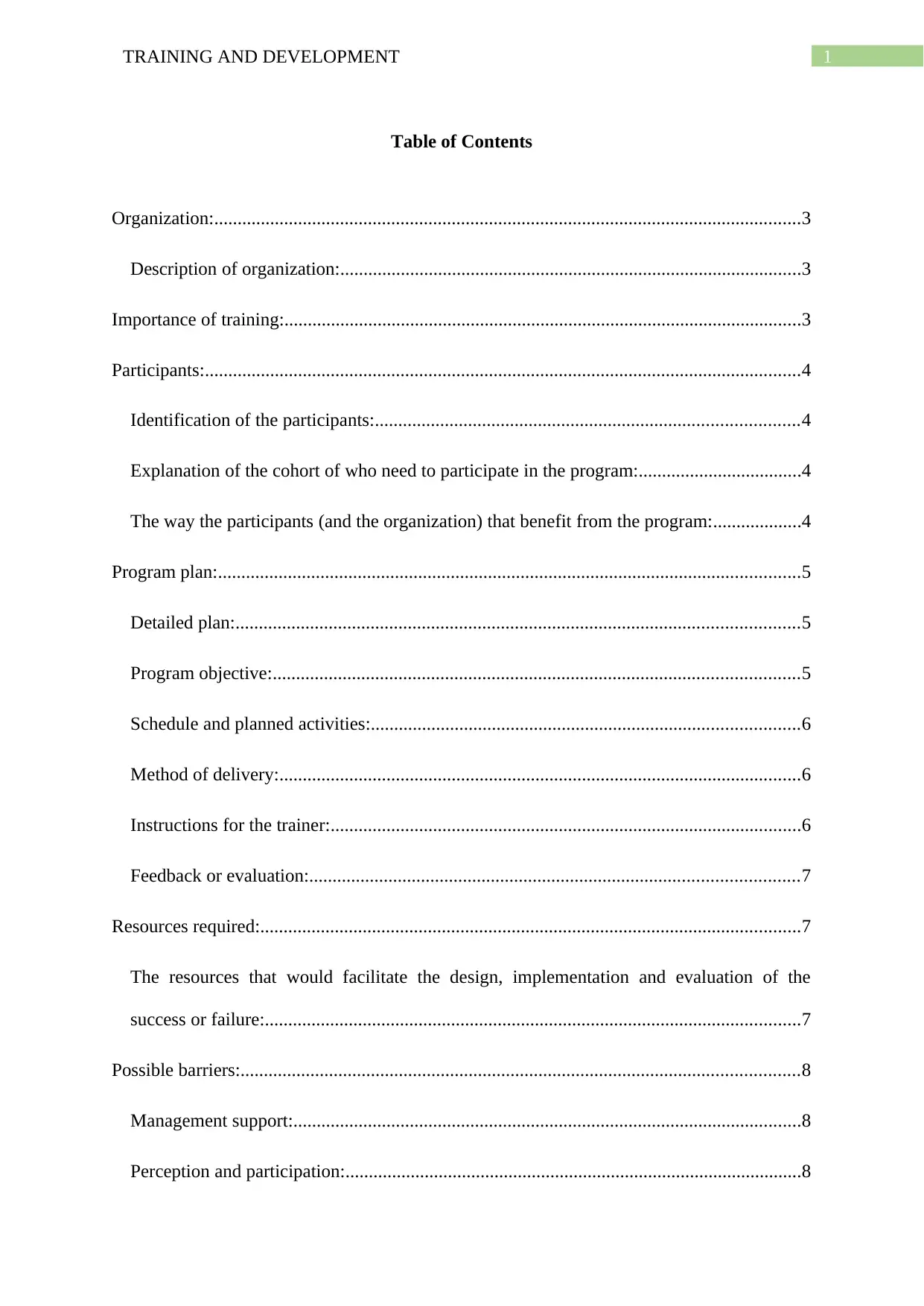
1TRAINING AND DEVELOPMENT
Table of Contents
Organization:..............................................................................................................................3
Description of organization:...................................................................................................3
Importance of training:...............................................................................................................3
Participants:................................................................................................................................4
Identification of the participants:...........................................................................................4
Explanation of the cohort of who need to participate in the program:...................................4
The way the participants (and the organization) that benefit from the program:...................4
Program plan:.............................................................................................................................5
Detailed plan:.........................................................................................................................5
Program objective:.................................................................................................................5
Schedule and planned activities:............................................................................................6
Method of delivery:................................................................................................................6
Instructions for the trainer:.....................................................................................................6
Feedback or evaluation:.........................................................................................................7
Resources required:....................................................................................................................7
The resources that would facilitate the design, implementation and evaluation of the
success or failure:...................................................................................................................7
Possible barriers:........................................................................................................................8
Management support:.............................................................................................................8
Perception and participation:..................................................................................................8
Table of Contents
Organization:..............................................................................................................................3
Description of organization:...................................................................................................3
Importance of training:...............................................................................................................3
Participants:................................................................................................................................4
Identification of the participants:...........................................................................................4
Explanation of the cohort of who need to participate in the program:...................................4
The way the participants (and the organization) that benefit from the program:...................4
Program plan:.............................................................................................................................5
Detailed plan:.........................................................................................................................5
Program objective:.................................................................................................................5
Schedule and planned activities:............................................................................................6
Method of delivery:................................................................................................................6
Instructions for the trainer:.....................................................................................................6
Feedback or evaluation:.........................................................................................................7
Resources required:....................................................................................................................7
The resources that would facilitate the design, implementation and evaluation of the
success or failure:...................................................................................................................7
Possible barriers:........................................................................................................................8
Management support:.............................................................................................................8
Perception and participation:..................................................................................................8
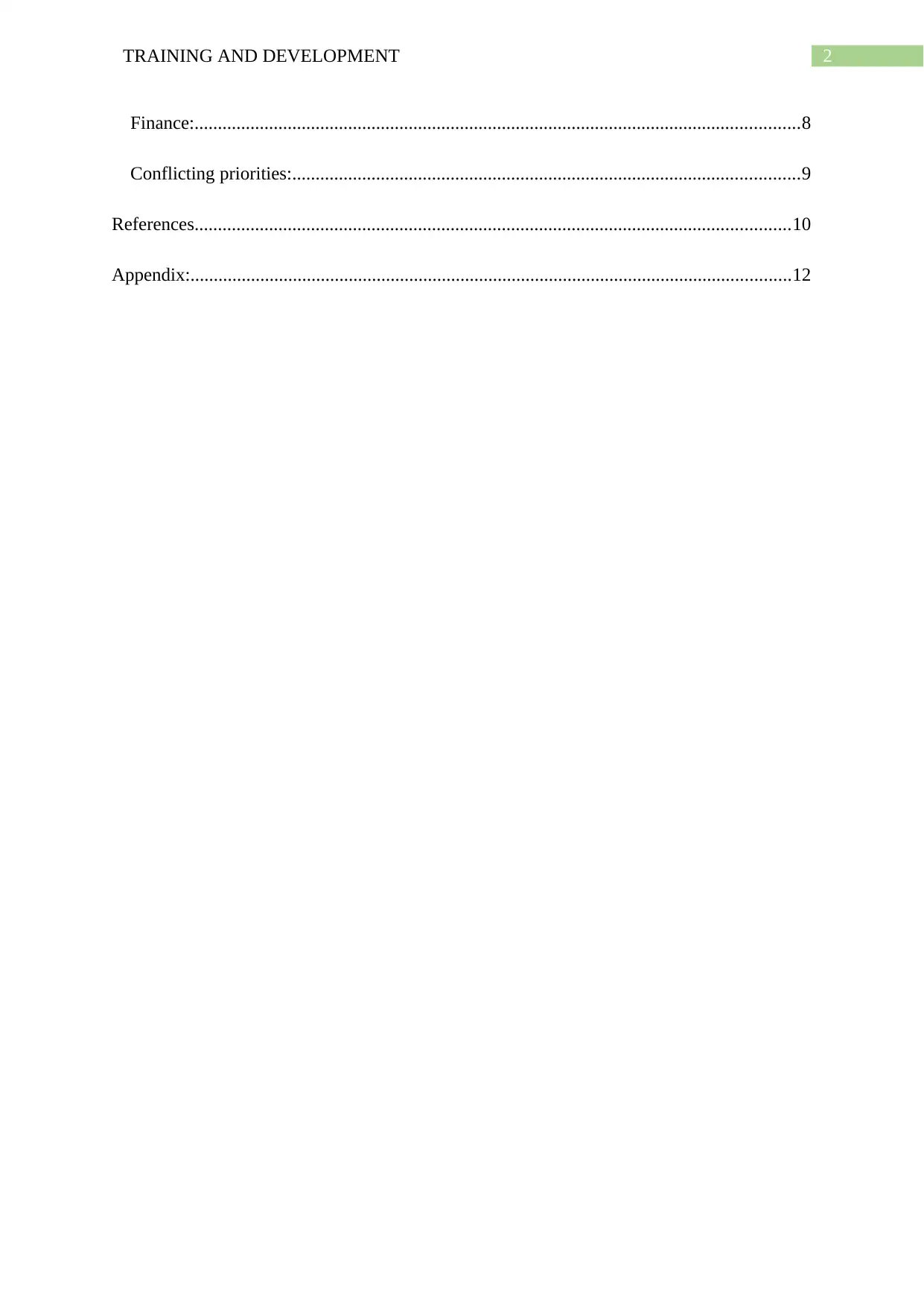
2TRAINING AND DEVELOPMENT
Finance:..................................................................................................................................8
Conflicting priorities:.............................................................................................................9
References................................................................................................................................10
Appendix:.................................................................................................................................12
Finance:..................................................................................................................................8
Conflicting priorities:.............................................................................................................9
References................................................................................................................................10
Appendix:.................................................................................................................................12
⊘ This is a preview!⊘
Do you want full access?
Subscribe today to unlock all pages.

Trusted by 1+ million students worldwide
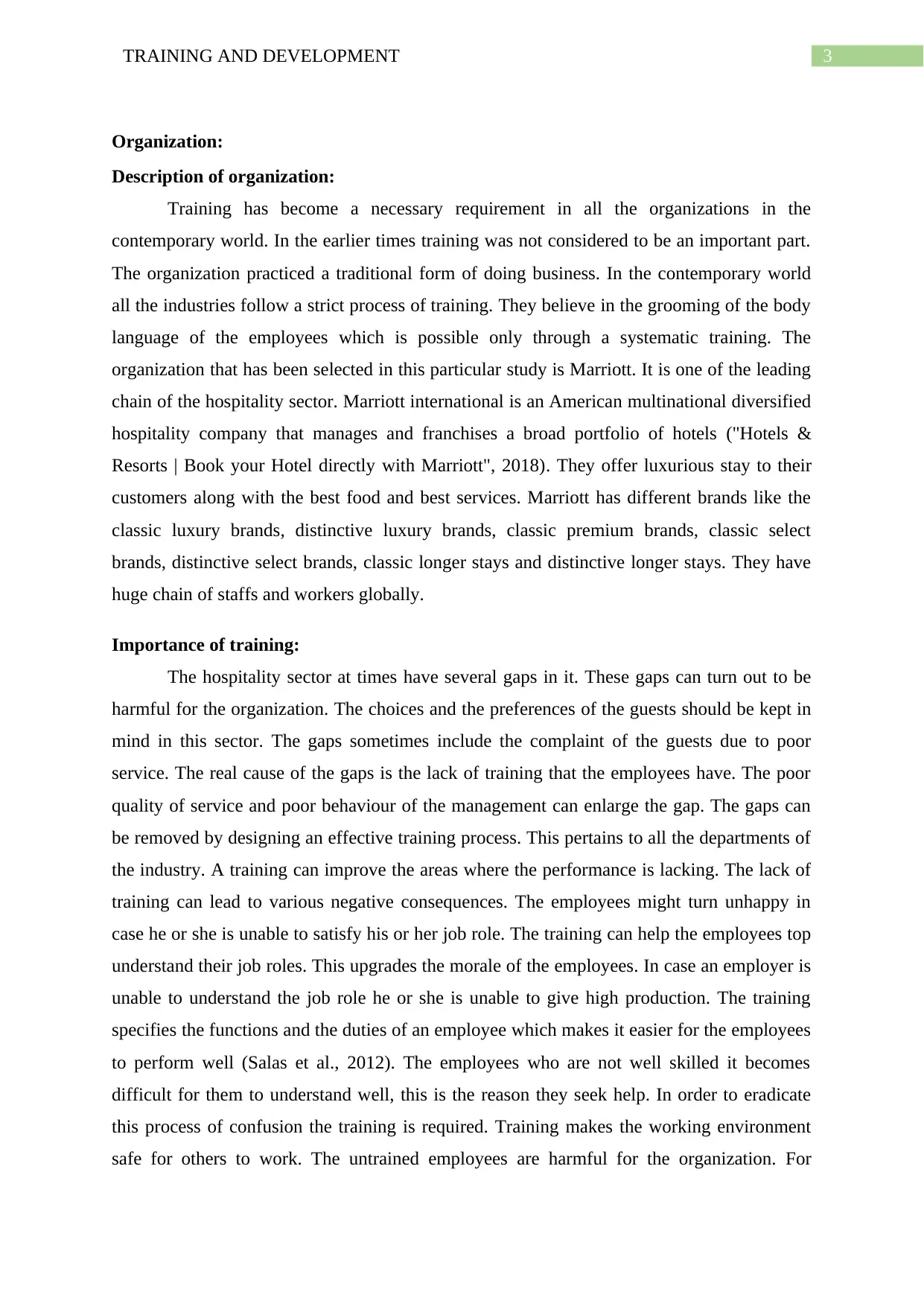
3TRAINING AND DEVELOPMENT
Organization:
Description of organization:
Training has become a necessary requirement in all the organizations in the
contemporary world. In the earlier times training was not considered to be an important part.
The organization practiced a traditional form of doing business. In the contemporary world
all the industries follow a strict process of training. They believe in the grooming of the body
language of the employees which is possible only through a systematic training. The
organization that has been selected in this particular study is Marriott. It is one of the leading
chain of the hospitality sector. Marriott international is an American multinational diversified
hospitality company that manages and franchises a broad portfolio of hotels ("Hotels &
Resorts | Book your Hotel directly with Marriott", 2018). They offer luxurious stay to their
customers along with the best food and best services. Marriott has different brands like the
classic luxury brands, distinctive luxury brands, classic premium brands, classic select
brands, distinctive select brands, classic longer stays and distinctive longer stays. They have
huge chain of staffs and workers globally.
Importance of training:
The hospitality sector at times have several gaps in it. These gaps can turn out to be
harmful for the organization. The choices and the preferences of the guests should be kept in
mind in this sector. The gaps sometimes include the complaint of the guests due to poor
service. The real cause of the gaps is the lack of training that the employees have. The poor
quality of service and poor behaviour of the management can enlarge the gap. The gaps can
be removed by designing an effective training process. This pertains to all the departments of
the industry. A training can improve the areas where the performance is lacking. The lack of
training can lead to various negative consequences. The employees might turn unhappy in
case he or she is unable to satisfy his or her job role. The training can help the employees top
understand their job roles. This upgrades the morale of the employees. In case an employer is
unable to understand the job role he or she is unable to give high production. The training
specifies the functions and the duties of an employee which makes it easier for the employees
to perform well (Salas et al., 2012). The employees who are not well skilled it becomes
difficult for them to understand well, this is the reason they seek help. In order to eradicate
this process of confusion the training is required. Training makes the working environment
safe for others to work. The untrained employees are harmful for the organization. For
Organization:
Description of organization:
Training has become a necessary requirement in all the organizations in the
contemporary world. In the earlier times training was not considered to be an important part.
The organization practiced a traditional form of doing business. In the contemporary world
all the industries follow a strict process of training. They believe in the grooming of the body
language of the employees which is possible only through a systematic training. The
organization that has been selected in this particular study is Marriott. It is one of the leading
chain of the hospitality sector. Marriott international is an American multinational diversified
hospitality company that manages and franchises a broad portfolio of hotels ("Hotels &
Resorts | Book your Hotel directly with Marriott", 2018). They offer luxurious stay to their
customers along with the best food and best services. Marriott has different brands like the
classic luxury brands, distinctive luxury brands, classic premium brands, classic select
brands, distinctive select brands, classic longer stays and distinctive longer stays. They have
huge chain of staffs and workers globally.
Importance of training:
The hospitality sector at times have several gaps in it. These gaps can turn out to be
harmful for the organization. The choices and the preferences of the guests should be kept in
mind in this sector. The gaps sometimes include the complaint of the guests due to poor
service. The real cause of the gaps is the lack of training that the employees have. The poor
quality of service and poor behaviour of the management can enlarge the gap. The gaps can
be removed by designing an effective training process. This pertains to all the departments of
the industry. A training can improve the areas where the performance is lacking. The lack of
training can lead to various negative consequences. The employees might turn unhappy in
case he or she is unable to satisfy his or her job role. The training can help the employees top
understand their job roles. This upgrades the morale of the employees. In case an employer is
unable to understand the job role he or she is unable to give high production. The training
specifies the functions and the duties of an employee which makes it easier for the employees
to perform well (Salas et al., 2012). The employees who are not well skilled it becomes
difficult for them to understand well, this is the reason they seek help. In order to eradicate
this process of confusion the training is required. Training makes the working environment
safe for others to work. The untrained employees are harmful for the organization. For
Paraphrase This Document
Need a fresh take? Get an instant paraphrase of this document with our AI Paraphraser
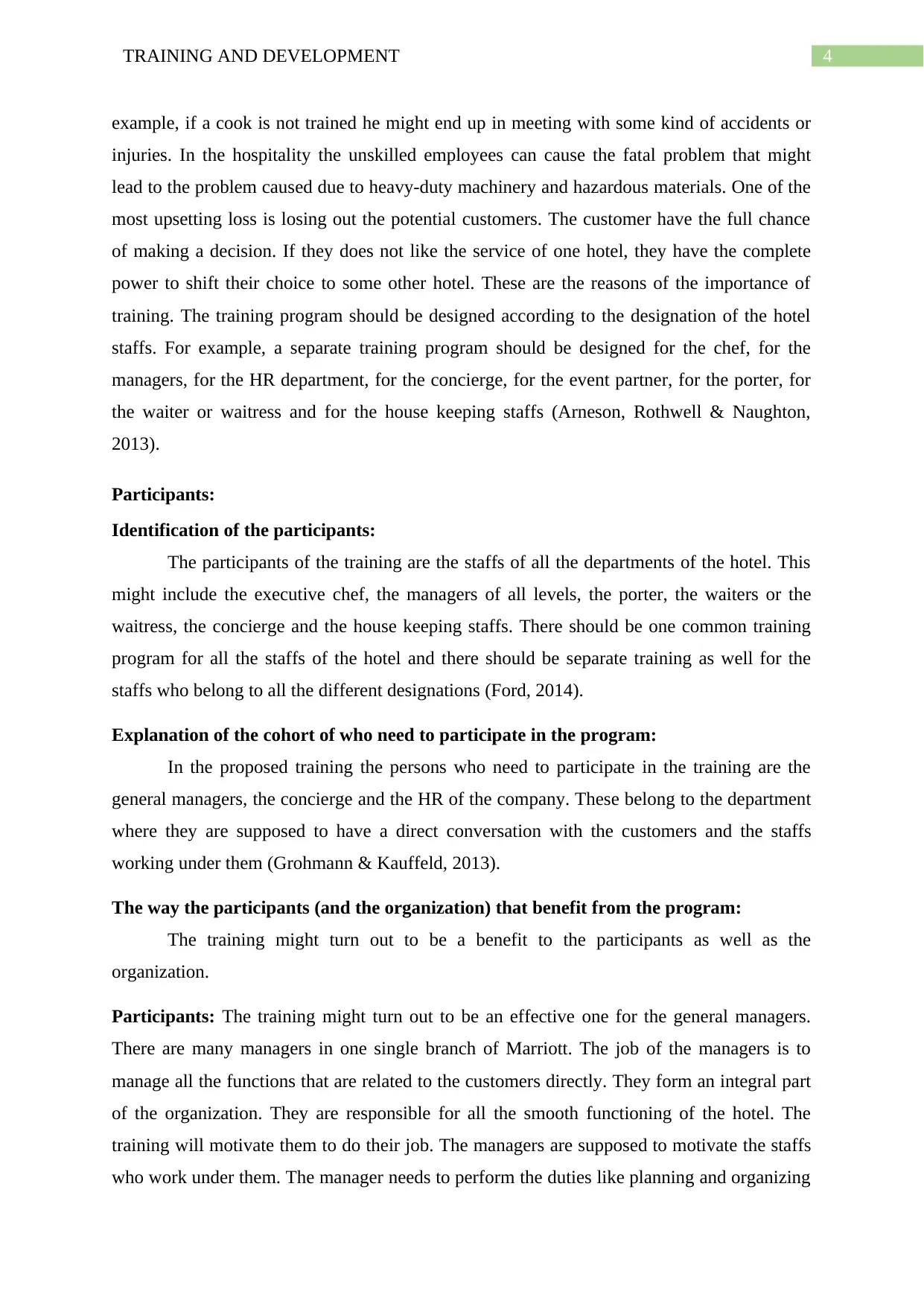
4TRAINING AND DEVELOPMENT
example, if a cook is not trained he might end up in meeting with some kind of accidents or
injuries. In the hospitality the unskilled employees can cause the fatal problem that might
lead to the problem caused due to heavy-duty machinery and hazardous materials. One of the
most upsetting loss is losing out the potential customers. The customer have the full chance
of making a decision. If they does not like the service of one hotel, they have the complete
power to shift their choice to some other hotel. These are the reasons of the importance of
training. The training program should be designed according to the designation of the hotel
staffs. For example, a separate training program should be designed for the chef, for the
managers, for the HR department, for the concierge, for the event partner, for the porter, for
the waiter or waitress and for the house keeping staffs (Arneson, Rothwell & Naughton,
2013).
Participants:
Identification of the participants:
The participants of the training are the staffs of all the departments of the hotel. This
might include the executive chef, the managers of all levels, the porter, the waiters or the
waitress, the concierge and the house keeping staffs. There should be one common training
program for all the staffs of the hotel and there should be separate training as well for the
staffs who belong to all the different designations (Ford, 2014).
Explanation of the cohort of who need to participate in the program:
In the proposed training the persons who need to participate in the training are the
general managers, the concierge and the HR of the company. These belong to the department
where they are supposed to have a direct conversation with the customers and the staffs
working under them (Grohmann & Kauffeld, 2013).
The way the participants (and the organization) that benefit from the program:
The training might turn out to be a benefit to the participants as well as the
organization.
Participants: The training might turn out to be an effective one for the general managers.
There are many managers in one single branch of Marriott. The job of the managers is to
manage all the functions that are related to the customers directly. They form an integral part
of the organization. They are responsible for all the smooth functioning of the hotel. The
training will motivate them to do their job. The managers are supposed to motivate the staffs
who work under them. The manager needs to perform the duties like planning and organizing
example, if a cook is not trained he might end up in meeting with some kind of accidents or
injuries. In the hospitality the unskilled employees can cause the fatal problem that might
lead to the problem caused due to heavy-duty machinery and hazardous materials. One of the
most upsetting loss is losing out the potential customers. The customer have the full chance
of making a decision. If they does not like the service of one hotel, they have the complete
power to shift their choice to some other hotel. These are the reasons of the importance of
training. The training program should be designed according to the designation of the hotel
staffs. For example, a separate training program should be designed for the chef, for the
managers, for the HR department, for the concierge, for the event partner, for the porter, for
the waiter or waitress and for the house keeping staffs (Arneson, Rothwell & Naughton,
2013).
Participants:
Identification of the participants:
The participants of the training are the staffs of all the departments of the hotel. This
might include the executive chef, the managers of all levels, the porter, the waiters or the
waitress, the concierge and the house keeping staffs. There should be one common training
program for all the staffs of the hotel and there should be separate training as well for the
staffs who belong to all the different designations (Ford, 2014).
Explanation of the cohort of who need to participate in the program:
In the proposed training the persons who need to participate in the training are the
general managers, the concierge and the HR of the company. These belong to the department
where they are supposed to have a direct conversation with the customers and the staffs
working under them (Grohmann & Kauffeld, 2013).
The way the participants (and the organization) that benefit from the program:
The training might turn out to be a benefit to the participants as well as the
organization.
Participants: The training might turn out to be an effective one for the general managers.
There are many managers in one single branch of Marriott. The job of the managers is to
manage all the functions that are related to the customers directly. They form an integral part
of the organization. They are responsible for all the smooth functioning of the hotel. The
training will motivate them to do their job. The managers are supposed to motivate the staffs
who work under them. The manager needs to perform the duties like planning and organizing
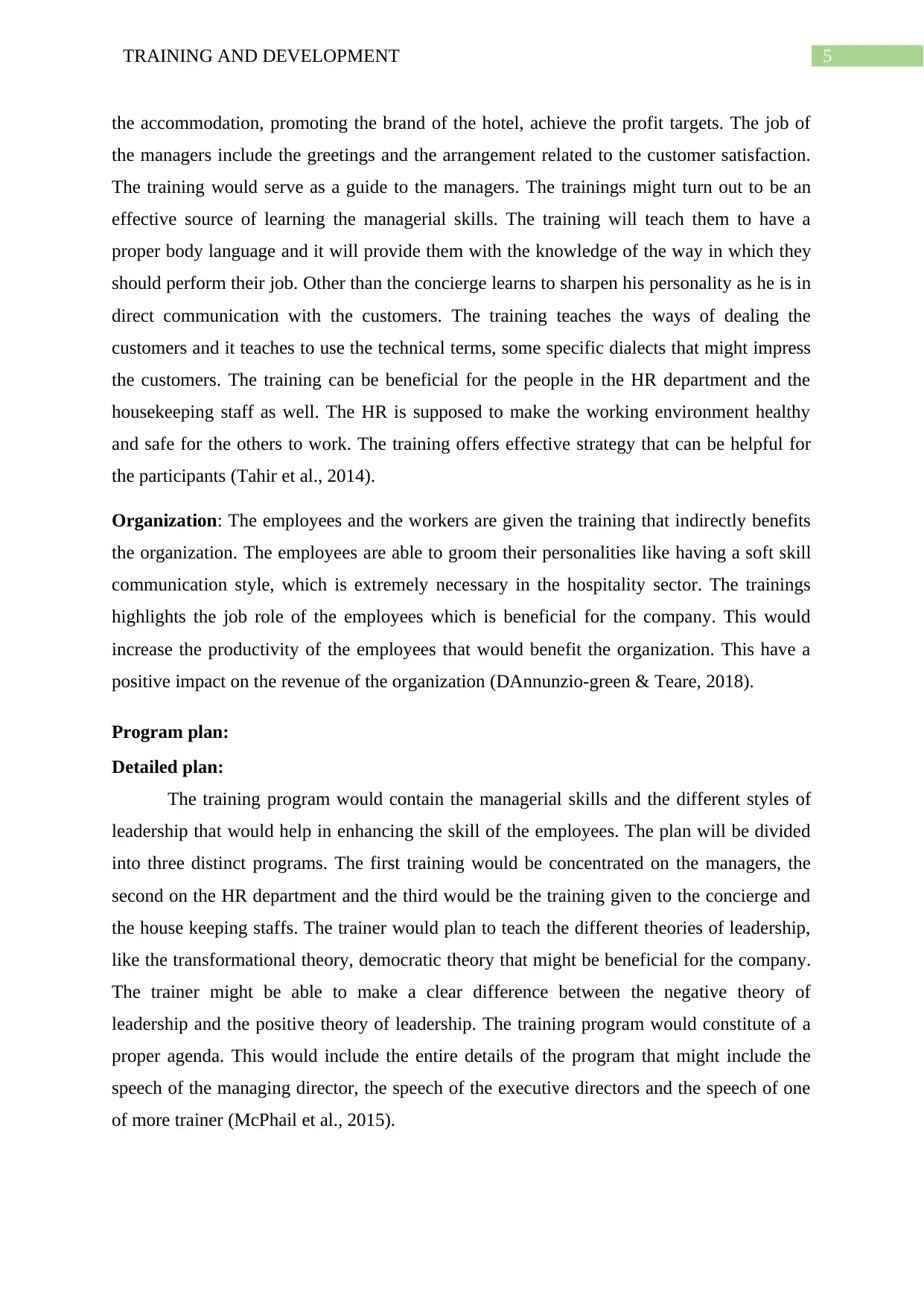
5TRAINING AND DEVELOPMENT
the accommodation, promoting the brand of the hotel, achieve the profit targets. The job of
the managers include the greetings and the arrangement related to the customer satisfaction.
The training would serve as a guide to the managers. The trainings might turn out to be an
effective source of learning the managerial skills. The training will teach them to have a
proper body language and it will provide them with the knowledge of the way in which they
should perform their job. Other than the concierge learns to sharpen his personality as he is in
direct communication with the customers. The training teaches the ways of dealing the
customers and it teaches to use the technical terms, some specific dialects that might impress
the customers. The training can be beneficial for the people in the HR department and the
housekeeping staff as well. The HR is supposed to make the working environment healthy
and safe for the others to work. The training offers effective strategy that can be helpful for
the participants (Tahir et al., 2014).
Organization: The employees and the workers are given the training that indirectly benefits
the organization. The employees are able to groom their personalities like having a soft skill
communication style, which is extremely necessary in the hospitality sector. The trainings
highlights the job role of the employees which is beneficial for the company. This would
increase the productivity of the employees that would benefit the organization. This have a
positive impact on the revenue of the organization (DAnnunzio-green & Teare, 2018).
Program plan:
Detailed plan:
The training program would contain the managerial skills and the different styles of
leadership that would help in enhancing the skill of the employees. The plan will be divided
into three distinct programs. The first training would be concentrated on the managers, the
second on the HR department and the third would be the training given to the concierge and
the house keeping staffs. The trainer would plan to teach the different theories of leadership,
like the transformational theory, democratic theory that might be beneficial for the company.
The trainer might be able to make a clear difference between the negative theory of
leadership and the positive theory of leadership. The training program would constitute of a
proper agenda. This would include the entire details of the program that might include the
speech of the managing director, the speech of the executive directors and the speech of one
of more trainer (McPhail et al., 2015).
the accommodation, promoting the brand of the hotel, achieve the profit targets. The job of
the managers include the greetings and the arrangement related to the customer satisfaction.
The training would serve as a guide to the managers. The trainings might turn out to be an
effective source of learning the managerial skills. The training will teach them to have a
proper body language and it will provide them with the knowledge of the way in which they
should perform their job. Other than the concierge learns to sharpen his personality as he is in
direct communication with the customers. The training teaches the ways of dealing the
customers and it teaches to use the technical terms, some specific dialects that might impress
the customers. The training can be beneficial for the people in the HR department and the
housekeeping staff as well. The HR is supposed to make the working environment healthy
and safe for the others to work. The training offers effective strategy that can be helpful for
the participants (Tahir et al., 2014).
Organization: The employees and the workers are given the training that indirectly benefits
the organization. The employees are able to groom their personalities like having a soft skill
communication style, which is extremely necessary in the hospitality sector. The trainings
highlights the job role of the employees which is beneficial for the company. This would
increase the productivity of the employees that would benefit the organization. This have a
positive impact on the revenue of the organization (DAnnunzio-green & Teare, 2018).
Program plan:
Detailed plan:
The training program would contain the managerial skills and the different styles of
leadership that would help in enhancing the skill of the employees. The plan will be divided
into three distinct programs. The first training would be concentrated on the managers, the
second on the HR department and the third would be the training given to the concierge and
the house keeping staffs. The trainer would plan to teach the different theories of leadership,
like the transformational theory, democratic theory that might be beneficial for the company.
The trainer might be able to make a clear difference between the negative theory of
leadership and the positive theory of leadership. The training program would constitute of a
proper agenda. This would include the entire details of the program that might include the
speech of the managing director, the speech of the executive directors and the speech of one
of more trainer (McPhail et al., 2015).
⊘ This is a preview!⊘
Do you want full access?
Subscribe today to unlock all pages.

Trusted by 1+ million students worldwide
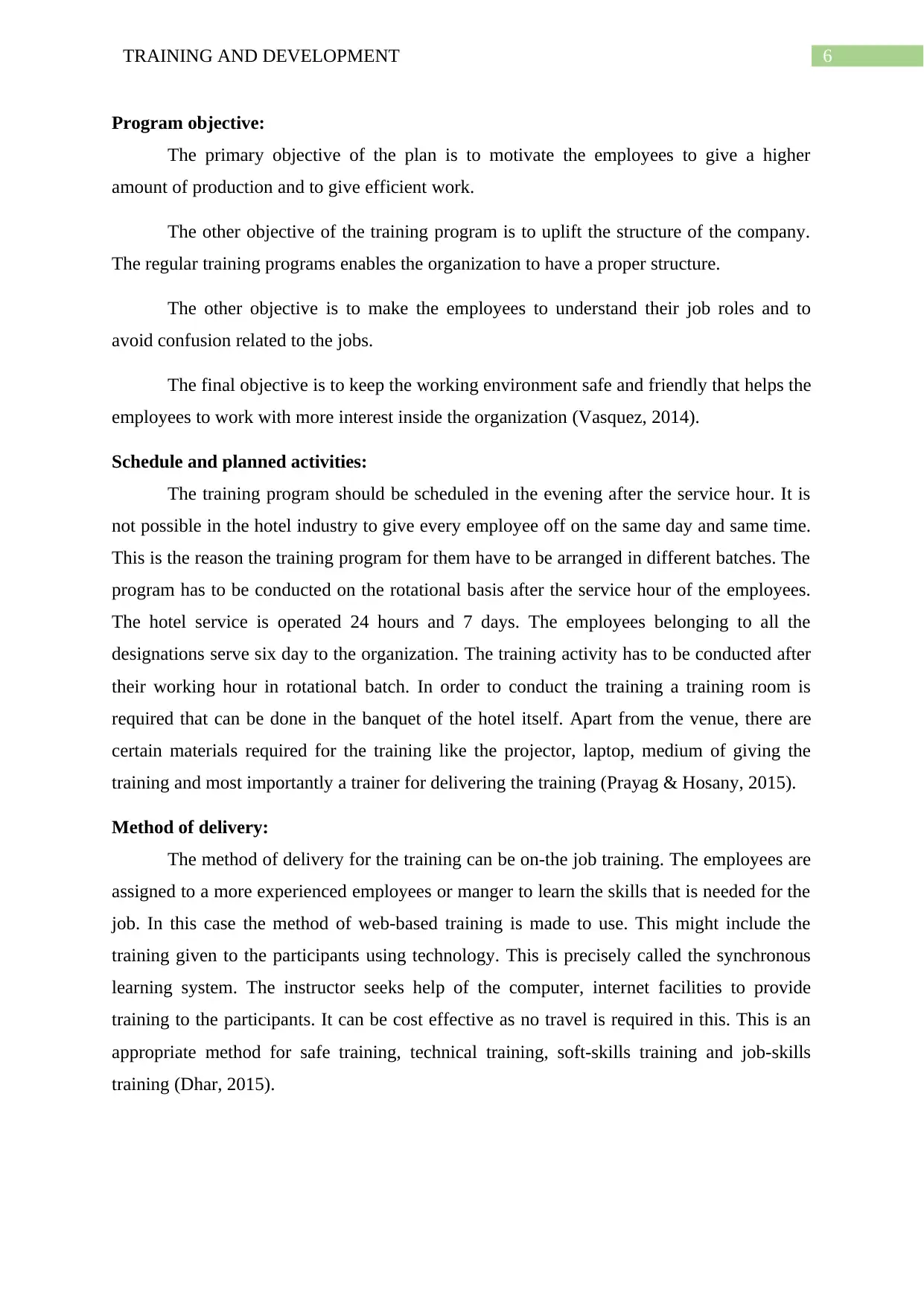
6TRAINING AND DEVELOPMENT
Program objective:
The primary objective of the plan is to motivate the employees to give a higher
amount of production and to give efficient work.
The other objective of the training program is to uplift the structure of the company.
The regular training programs enables the organization to have a proper structure.
The other objective is to make the employees to understand their job roles and to
avoid confusion related to the jobs.
The final objective is to keep the working environment safe and friendly that helps the
employees to work with more interest inside the organization (Vasquez, 2014).
Schedule and planned activities:
The training program should be scheduled in the evening after the service hour. It is
not possible in the hotel industry to give every employee off on the same day and same time.
This is the reason the training program for them have to be arranged in different batches. The
program has to be conducted on the rotational basis after the service hour of the employees.
The hotel service is operated 24 hours and 7 days. The employees belonging to all the
designations serve six day to the organization. The training activity has to be conducted after
their working hour in rotational batch. In order to conduct the training a training room is
required that can be done in the banquet of the hotel itself. Apart from the venue, there are
certain materials required for the training like the projector, laptop, medium of giving the
training and most importantly a trainer for delivering the training (Prayag & Hosany, 2015).
Method of delivery:
The method of delivery for the training can be on-the job training. The employees are
assigned to a more experienced employees or manger to learn the skills that is needed for the
job. In this case the method of web-based training is made to use. This might include the
training given to the participants using technology. This is precisely called the synchronous
learning system. The instructor seeks help of the computer, internet facilities to provide
training to the participants. It can be cost effective as no travel is required in this. This is an
appropriate method for safe training, technical training, soft-skills training and job-skills
training (Dhar, 2015).
Program objective:
The primary objective of the plan is to motivate the employees to give a higher
amount of production and to give efficient work.
The other objective of the training program is to uplift the structure of the company.
The regular training programs enables the organization to have a proper structure.
The other objective is to make the employees to understand their job roles and to
avoid confusion related to the jobs.
The final objective is to keep the working environment safe and friendly that helps the
employees to work with more interest inside the organization (Vasquez, 2014).
Schedule and planned activities:
The training program should be scheduled in the evening after the service hour. It is
not possible in the hotel industry to give every employee off on the same day and same time.
This is the reason the training program for them have to be arranged in different batches. The
program has to be conducted on the rotational basis after the service hour of the employees.
The hotel service is operated 24 hours and 7 days. The employees belonging to all the
designations serve six day to the organization. The training activity has to be conducted after
their working hour in rotational batch. In order to conduct the training a training room is
required that can be done in the banquet of the hotel itself. Apart from the venue, there are
certain materials required for the training like the projector, laptop, medium of giving the
training and most importantly a trainer for delivering the training (Prayag & Hosany, 2015).
Method of delivery:
The method of delivery for the training can be on-the job training. The employees are
assigned to a more experienced employees or manger to learn the skills that is needed for the
job. In this case the method of web-based training is made to use. This might include the
training given to the participants using technology. This is precisely called the synchronous
learning system. The instructor seeks help of the computer, internet facilities to provide
training to the participants. It can be cost effective as no travel is required in this. This is an
appropriate method for safe training, technical training, soft-skills training and job-skills
training (Dhar, 2015).
Paraphrase This Document
Need a fresh take? Get an instant paraphrase of this document with our AI Paraphraser
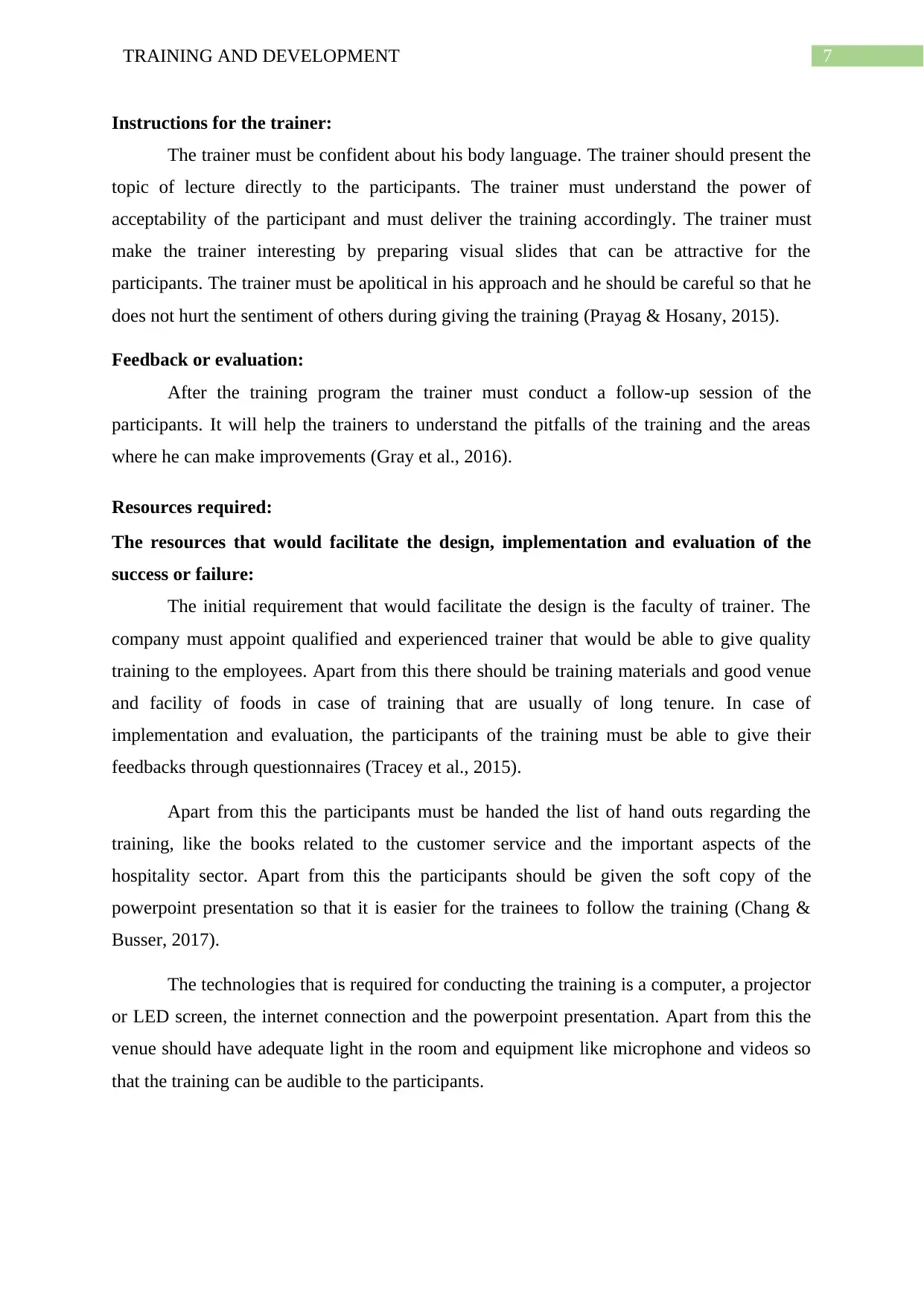
7TRAINING AND DEVELOPMENT
Instructions for the trainer:
The trainer must be confident about his body language. The trainer should present the
topic of lecture directly to the participants. The trainer must understand the power of
acceptability of the participant and must deliver the training accordingly. The trainer must
make the trainer interesting by preparing visual slides that can be attractive for the
participants. The trainer must be apolitical in his approach and he should be careful so that he
does not hurt the sentiment of others during giving the training (Prayag & Hosany, 2015).
Feedback or evaluation:
After the training program the trainer must conduct a follow-up session of the
participants. It will help the trainers to understand the pitfalls of the training and the areas
where he can make improvements (Gray et al., 2016).
Resources required:
The resources that would facilitate the design, implementation and evaluation of the
success or failure:
The initial requirement that would facilitate the design is the faculty of trainer. The
company must appoint qualified and experienced trainer that would be able to give quality
training to the employees. Apart from this there should be training materials and good venue
and facility of foods in case of training that are usually of long tenure. In case of
implementation and evaluation, the participants of the training must be able to give their
feedbacks through questionnaires (Tracey et al., 2015).
Apart from this the participants must be handed the list of hand outs regarding the
training, like the books related to the customer service and the important aspects of the
hospitality sector. Apart from this the participants should be given the soft copy of the
powerpoint presentation so that it is easier for the trainees to follow the training (Chang &
Busser, 2017).
The technologies that is required for conducting the training is a computer, a projector
or LED screen, the internet connection and the powerpoint presentation. Apart from this the
venue should have adequate light in the room and equipment like microphone and videos so
that the training can be audible to the participants.
Instructions for the trainer:
The trainer must be confident about his body language. The trainer should present the
topic of lecture directly to the participants. The trainer must understand the power of
acceptability of the participant and must deliver the training accordingly. The trainer must
make the trainer interesting by preparing visual slides that can be attractive for the
participants. The trainer must be apolitical in his approach and he should be careful so that he
does not hurt the sentiment of others during giving the training (Prayag & Hosany, 2015).
Feedback or evaluation:
After the training program the trainer must conduct a follow-up session of the
participants. It will help the trainers to understand the pitfalls of the training and the areas
where he can make improvements (Gray et al., 2016).
Resources required:
The resources that would facilitate the design, implementation and evaluation of the
success or failure:
The initial requirement that would facilitate the design is the faculty of trainer. The
company must appoint qualified and experienced trainer that would be able to give quality
training to the employees. Apart from this there should be training materials and good venue
and facility of foods in case of training that are usually of long tenure. In case of
implementation and evaluation, the participants of the training must be able to give their
feedbacks through questionnaires (Tracey et al., 2015).
Apart from this the participants must be handed the list of hand outs regarding the
training, like the books related to the customer service and the important aspects of the
hospitality sector. Apart from this the participants should be given the soft copy of the
powerpoint presentation so that it is easier for the trainees to follow the training (Chang &
Busser, 2017).
The technologies that is required for conducting the training is a computer, a projector
or LED screen, the internet connection and the powerpoint presentation. Apart from this the
venue should have adequate light in the room and equipment like microphone and videos so
that the training can be audible to the participants.
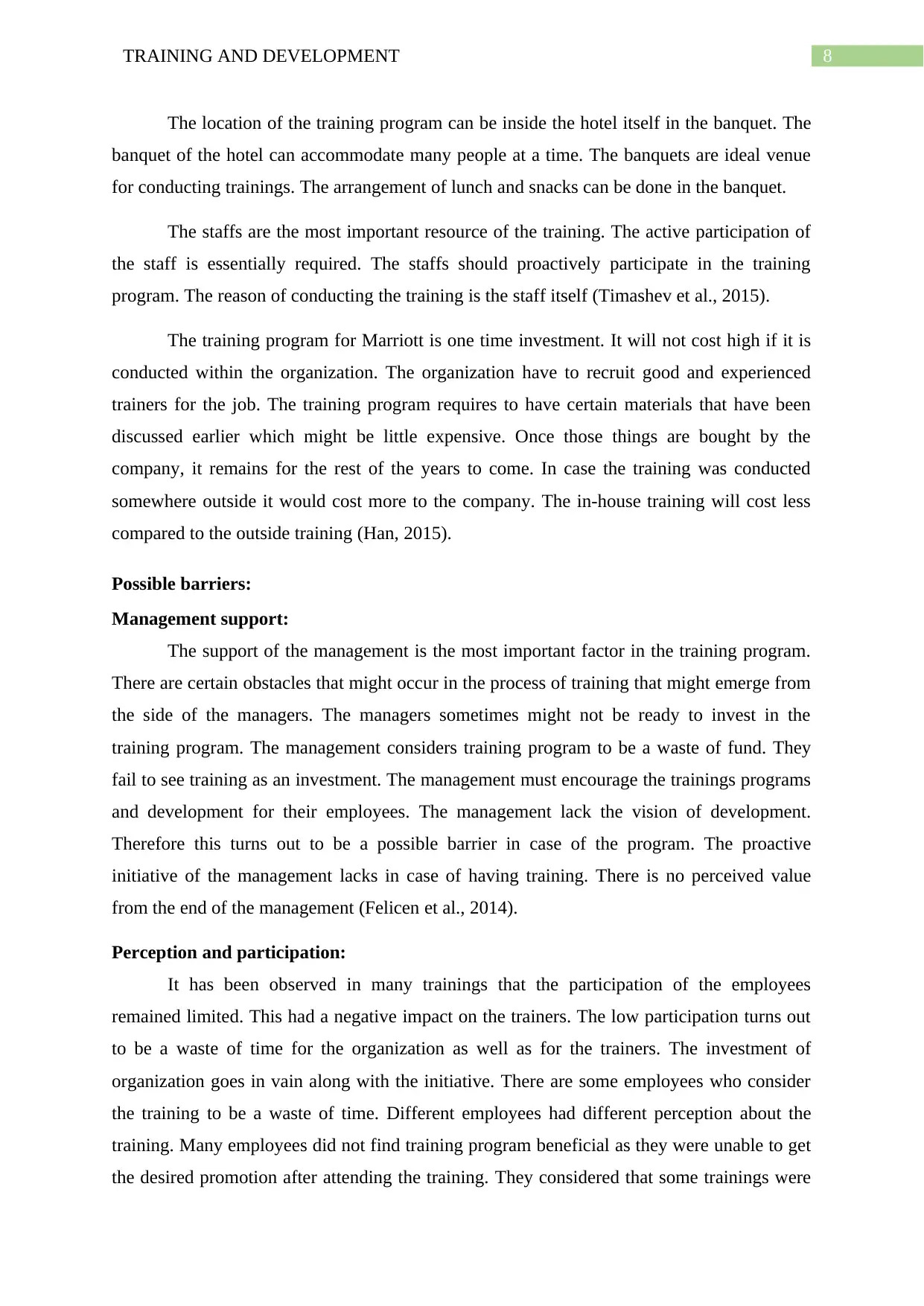
8TRAINING AND DEVELOPMENT
The location of the training program can be inside the hotel itself in the banquet. The
banquet of the hotel can accommodate many people at a time. The banquets are ideal venue
for conducting trainings. The arrangement of lunch and snacks can be done in the banquet.
The staffs are the most important resource of the training. The active participation of
the staff is essentially required. The staffs should proactively participate in the training
program. The reason of conducting the training is the staff itself (Timashev et al., 2015).
The training program for Marriott is one time investment. It will not cost high if it is
conducted within the organization. The organization have to recruit good and experienced
trainers for the job. The training program requires to have certain materials that have been
discussed earlier which might be little expensive. Once those things are bought by the
company, it remains for the rest of the years to come. In case the training was conducted
somewhere outside it would cost more to the company. The in-house training will cost less
compared to the outside training (Han, 2015).
Possible barriers:
Management support:
The support of the management is the most important factor in the training program.
There are certain obstacles that might occur in the process of training that might emerge from
the side of the managers. The managers sometimes might not be ready to invest in the
training program. The management considers training program to be a waste of fund. They
fail to see training as an investment. The management must encourage the trainings programs
and development for their employees. The management lack the vision of development.
Therefore this turns out to be a possible barrier in case of the program. The proactive
initiative of the management lacks in case of having training. There is no perceived value
from the end of the management (Felicen et al., 2014).
Perception and participation:
It has been observed in many trainings that the participation of the employees
remained limited. This had a negative impact on the trainers. The low participation turns out
to be a waste of time for the organization as well as for the trainers. The investment of
organization goes in vain along with the initiative. There are some employees who consider
the training to be a waste of time. Different employees had different perception about the
training. Many employees did not find training program beneficial as they were unable to get
the desired promotion after attending the training. They considered that some trainings were
The location of the training program can be inside the hotel itself in the banquet. The
banquet of the hotel can accommodate many people at a time. The banquets are ideal venue
for conducting trainings. The arrangement of lunch and snacks can be done in the banquet.
The staffs are the most important resource of the training. The active participation of
the staff is essentially required. The staffs should proactively participate in the training
program. The reason of conducting the training is the staff itself (Timashev et al., 2015).
The training program for Marriott is one time investment. It will not cost high if it is
conducted within the organization. The organization have to recruit good and experienced
trainers for the job. The training program requires to have certain materials that have been
discussed earlier which might be little expensive. Once those things are bought by the
company, it remains for the rest of the years to come. In case the training was conducted
somewhere outside it would cost more to the company. The in-house training will cost less
compared to the outside training (Han, 2015).
Possible barriers:
Management support:
The support of the management is the most important factor in the training program.
There are certain obstacles that might occur in the process of training that might emerge from
the side of the managers. The managers sometimes might not be ready to invest in the
training program. The management considers training program to be a waste of fund. They
fail to see training as an investment. The management must encourage the trainings programs
and development for their employees. The management lack the vision of development.
Therefore this turns out to be a possible barrier in case of the program. The proactive
initiative of the management lacks in case of having training. There is no perceived value
from the end of the management (Felicen et al., 2014).
Perception and participation:
It has been observed in many trainings that the participation of the employees
remained limited. This had a negative impact on the trainers. The low participation turns out
to be a waste of time for the organization as well as for the trainers. The investment of
organization goes in vain along with the initiative. There are some employees who consider
the training to be a waste of time. Different employees had different perception about the
training. Many employees did not find training program beneficial as they were unable to get
the desired promotion after attending the training. They considered that some trainings were
⊘ This is a preview!⊘
Do you want full access?
Subscribe today to unlock all pages.

Trusted by 1+ million students worldwide
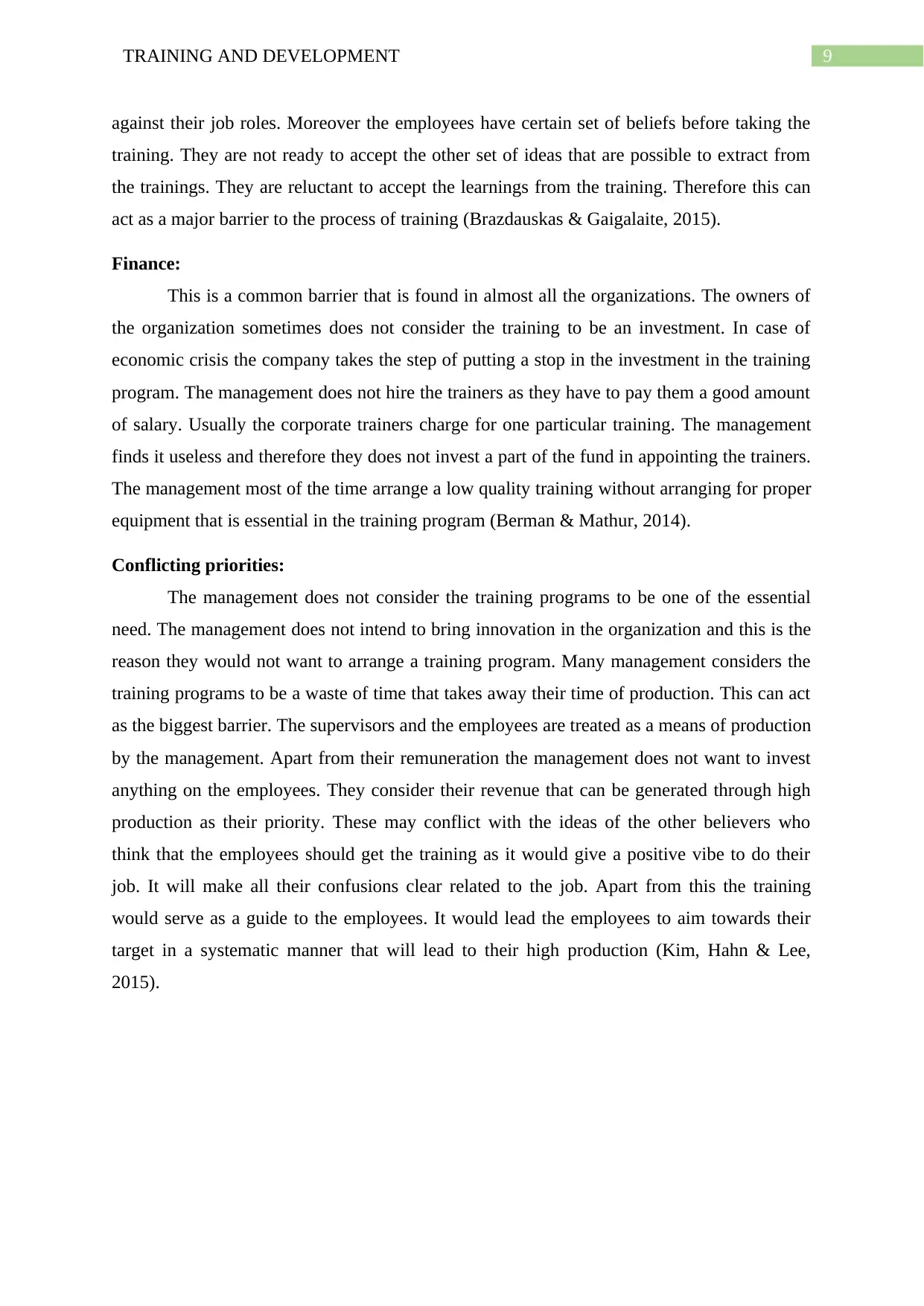
9TRAINING AND DEVELOPMENT
against their job roles. Moreover the employees have certain set of beliefs before taking the
training. They are not ready to accept the other set of ideas that are possible to extract from
the trainings. They are reluctant to accept the learnings from the training. Therefore this can
act as a major barrier to the process of training (Brazdauskas & Gaigalaite, 2015).
Finance:
This is a common barrier that is found in almost all the organizations. The owners of
the organization sometimes does not consider the training to be an investment. In case of
economic crisis the company takes the step of putting a stop in the investment in the training
program. The management does not hire the trainers as they have to pay them a good amount
of salary. Usually the corporate trainers charge for one particular training. The management
finds it useless and therefore they does not invest a part of the fund in appointing the trainers.
The management most of the time arrange a low quality training without arranging for proper
equipment that is essential in the training program (Berman & Mathur, 2014).
Conflicting priorities:
The management does not consider the training programs to be one of the essential
need. The management does not intend to bring innovation in the organization and this is the
reason they would not want to arrange a training program. Many management considers the
training programs to be a waste of time that takes away their time of production. This can act
as the biggest barrier. The supervisors and the employees are treated as a means of production
by the management. Apart from their remuneration the management does not want to invest
anything on the employees. They consider their revenue that can be generated through high
production as their priority. These may conflict with the ideas of the other believers who
think that the employees should get the training as it would give a positive vibe to do their
job. It will make all their confusions clear related to the job. Apart from this the training
would serve as a guide to the employees. It would lead the employees to aim towards their
target in a systematic manner that will lead to their high production (Kim, Hahn & Lee,
2015).
against their job roles. Moreover the employees have certain set of beliefs before taking the
training. They are not ready to accept the other set of ideas that are possible to extract from
the trainings. They are reluctant to accept the learnings from the training. Therefore this can
act as a major barrier to the process of training (Brazdauskas & Gaigalaite, 2015).
Finance:
This is a common barrier that is found in almost all the organizations. The owners of
the organization sometimes does not consider the training to be an investment. In case of
economic crisis the company takes the step of putting a stop in the investment in the training
program. The management does not hire the trainers as they have to pay them a good amount
of salary. Usually the corporate trainers charge for one particular training. The management
finds it useless and therefore they does not invest a part of the fund in appointing the trainers.
The management most of the time arrange a low quality training without arranging for proper
equipment that is essential in the training program (Berman & Mathur, 2014).
Conflicting priorities:
The management does not consider the training programs to be one of the essential
need. The management does not intend to bring innovation in the organization and this is the
reason they would not want to arrange a training program. Many management considers the
training programs to be a waste of time that takes away their time of production. This can act
as the biggest barrier. The supervisors and the employees are treated as a means of production
by the management. Apart from their remuneration the management does not want to invest
anything on the employees. They consider their revenue that can be generated through high
production as their priority. These may conflict with the ideas of the other believers who
think that the employees should get the training as it would give a positive vibe to do their
job. It will make all their confusions clear related to the job. Apart from this the training
would serve as a guide to the employees. It would lead the employees to aim towards their
target in a systematic manner that will lead to their high production (Kim, Hahn & Lee,
2015).
Paraphrase This Document
Need a fresh take? Get an instant paraphrase of this document with our AI Paraphraser
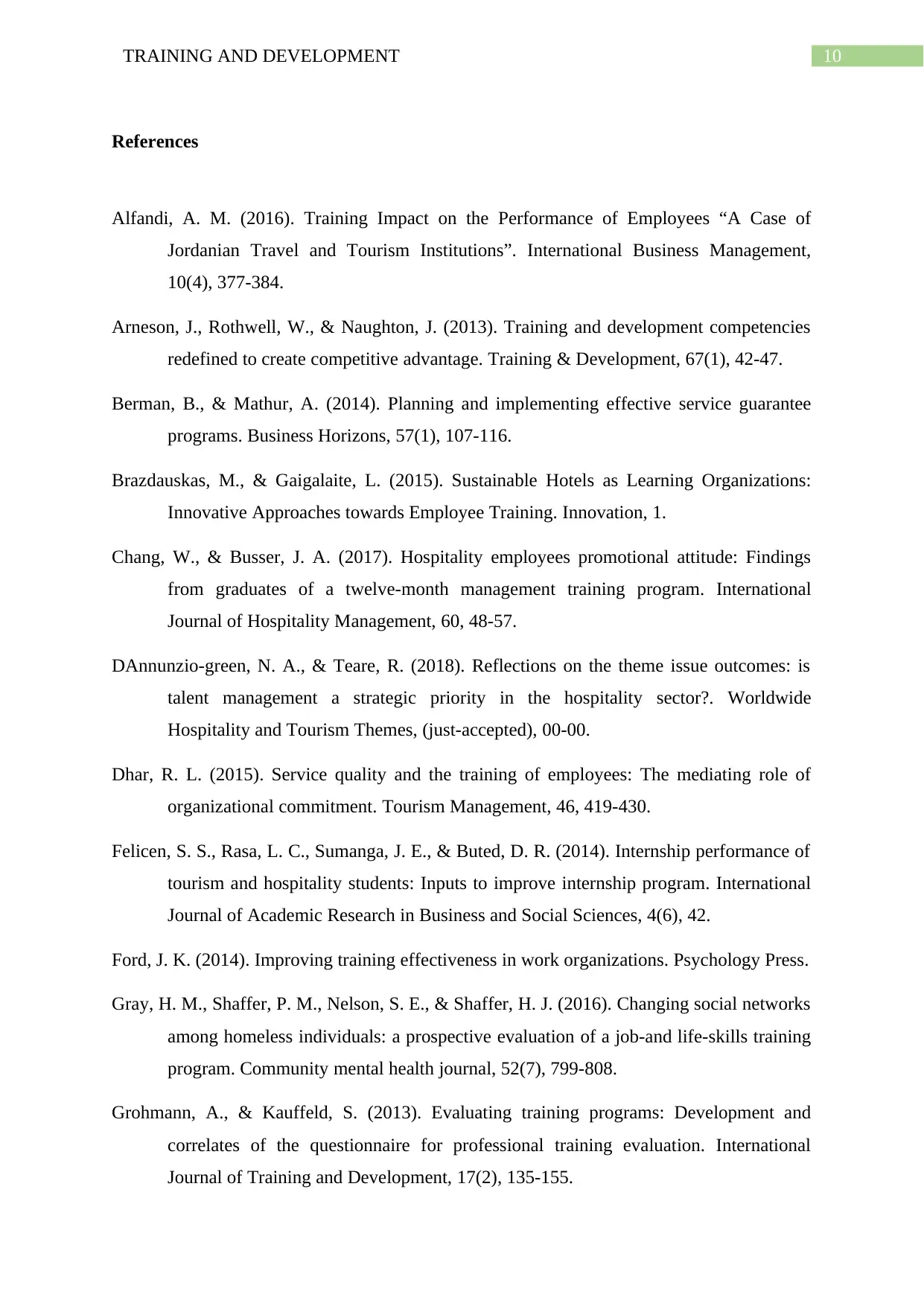
10TRAINING AND DEVELOPMENT
References
Alfandi, A. M. (2016). Training Impact on the Performance of Employees “A Case of
Jordanian Travel and Tourism Institutions”. International Business Management,
10(4), 377-384.
Arneson, J., Rothwell, W., & Naughton, J. (2013). Training and development competencies
redefined to create competitive advantage. Training & Development, 67(1), 42-47.
Berman, B., & Mathur, A. (2014). Planning and implementing effective service guarantee
programs. Business Horizons, 57(1), 107-116.
Brazdauskas, M., & Gaigalaite, L. (2015). Sustainable Hotels as Learning Organizations:
Innovative Approaches towards Employee Training. Innovation, 1.
Chang, W., & Busser, J. A. (2017). Hospitality employees promotional attitude: Findings
from graduates of a twelve-month management training program. International
Journal of Hospitality Management, 60, 48-57.
DAnnunzio-green, N. A., & Teare, R. (2018). Reflections on the theme issue outcomes: is
talent management a strategic priority in the hospitality sector?. Worldwide
Hospitality and Tourism Themes, (just-accepted), 00-00.
Dhar, R. L. (2015). Service quality and the training of employees: The mediating role of
organizational commitment. Tourism Management, 46, 419-430.
Felicen, S. S., Rasa, L. C., Sumanga, J. E., & Buted, D. R. (2014). Internship performance of
tourism and hospitality students: Inputs to improve internship program. International
Journal of Academic Research in Business and Social Sciences, 4(6), 42.
Ford, J. K. (2014). Improving training effectiveness in work organizations. Psychology Press.
Gray, H. M., Shaffer, P. M., Nelson, S. E., & Shaffer, H. J. (2016). Changing social networks
among homeless individuals: a prospective evaluation of a job-and life-skills training
program. Community mental health journal, 52(7), 799-808.
Grohmann, A., & Kauffeld, S. (2013). Evaluating training programs: Development and
correlates of the questionnaire for professional training evaluation. International
Journal of Training and Development, 17(2), 135-155.
References
Alfandi, A. M. (2016). Training Impact on the Performance of Employees “A Case of
Jordanian Travel and Tourism Institutions”. International Business Management,
10(4), 377-384.
Arneson, J., Rothwell, W., & Naughton, J. (2013). Training and development competencies
redefined to create competitive advantage. Training & Development, 67(1), 42-47.
Berman, B., & Mathur, A. (2014). Planning and implementing effective service guarantee
programs. Business Horizons, 57(1), 107-116.
Brazdauskas, M., & Gaigalaite, L. (2015). Sustainable Hotels as Learning Organizations:
Innovative Approaches towards Employee Training. Innovation, 1.
Chang, W., & Busser, J. A. (2017). Hospitality employees promotional attitude: Findings
from graduates of a twelve-month management training program. International
Journal of Hospitality Management, 60, 48-57.
DAnnunzio-green, N. A., & Teare, R. (2018). Reflections on the theme issue outcomes: is
talent management a strategic priority in the hospitality sector?. Worldwide
Hospitality and Tourism Themes, (just-accepted), 00-00.
Dhar, R. L. (2015). Service quality and the training of employees: The mediating role of
organizational commitment. Tourism Management, 46, 419-430.
Felicen, S. S., Rasa, L. C., Sumanga, J. E., & Buted, D. R. (2014). Internship performance of
tourism and hospitality students: Inputs to improve internship program. International
Journal of Academic Research in Business and Social Sciences, 4(6), 42.
Ford, J. K. (2014). Improving training effectiveness in work organizations. Psychology Press.
Gray, H. M., Shaffer, P. M., Nelson, S. E., & Shaffer, H. J. (2016). Changing social networks
among homeless individuals: a prospective evaluation of a job-and life-skills training
program. Community mental health journal, 52(7), 799-808.
Grohmann, A., & Kauffeld, S. (2013). Evaluating training programs: Development and
correlates of the questionnaire for professional training evaluation. International
Journal of Training and Development, 17(2), 135-155.
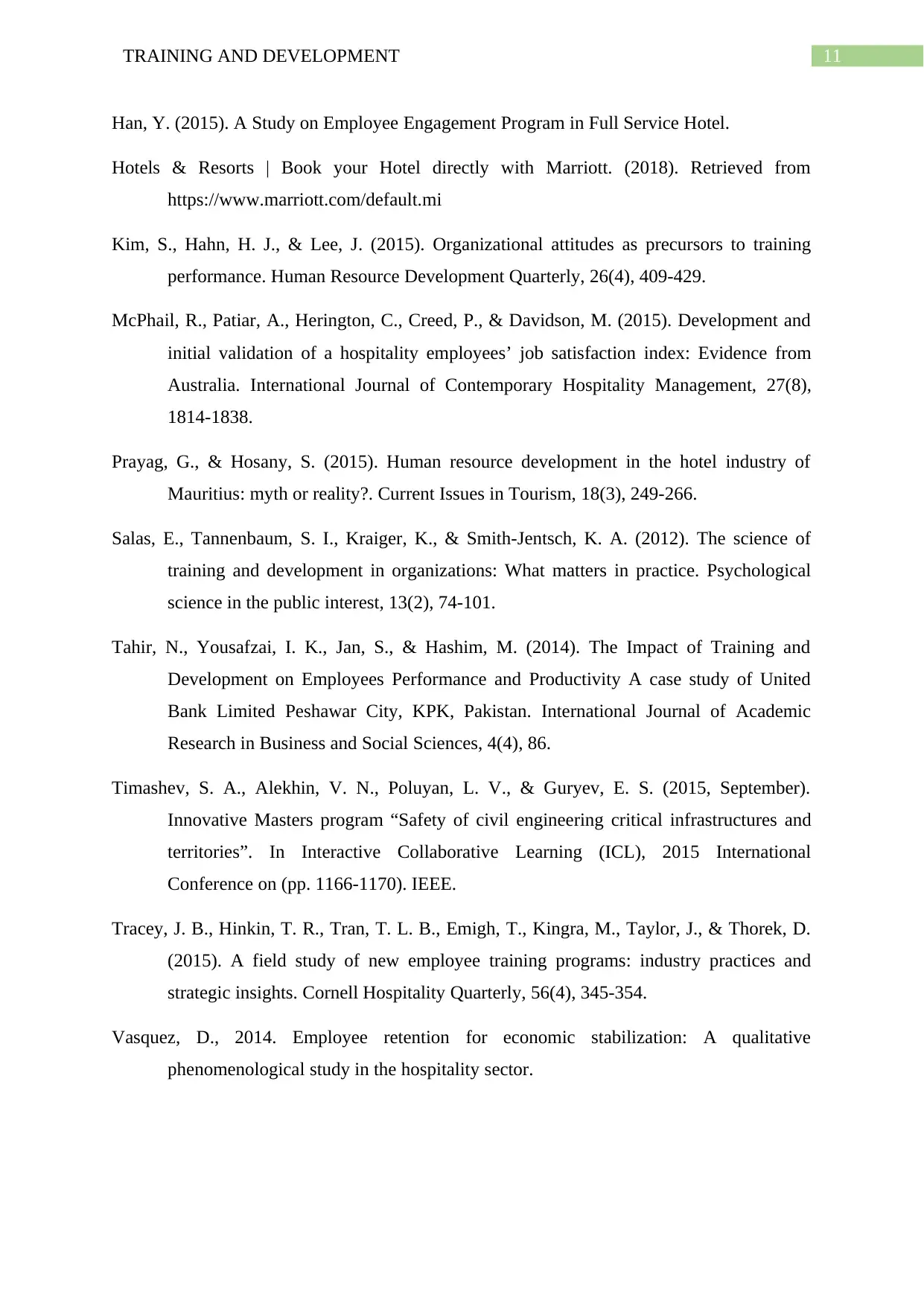
11TRAINING AND DEVELOPMENT
Han, Y. (2015). A Study on Employee Engagement Program in Full Service Hotel.
Hotels & Resorts | Book your Hotel directly with Marriott. (2018). Retrieved from
https://www.marriott.com/default.mi
Kim, S., Hahn, H. J., & Lee, J. (2015). Organizational attitudes as precursors to training
performance. Human Resource Development Quarterly, 26(4), 409-429.
McPhail, R., Patiar, A., Herington, C., Creed, P., & Davidson, M. (2015). Development and
initial validation of a hospitality employees’ job satisfaction index: Evidence from
Australia. International Journal of Contemporary Hospitality Management, 27(8),
1814-1838.
Prayag, G., & Hosany, S. (2015). Human resource development in the hotel industry of
Mauritius: myth or reality?. Current Issues in Tourism, 18(3), 249-266.
Salas, E., Tannenbaum, S. I., Kraiger, K., & Smith-Jentsch, K. A. (2012). The science of
training and development in organizations: What matters in practice. Psychological
science in the public interest, 13(2), 74-101.
Tahir, N., Yousafzai, I. K., Jan, S., & Hashim, M. (2014). The Impact of Training and
Development on Employees Performance and Productivity A case study of United
Bank Limited Peshawar City, KPK, Pakistan. International Journal of Academic
Research in Business and Social Sciences, 4(4), 86.
Timashev, S. A., Alekhin, V. N., Poluyan, L. V., & Guryev, E. S. (2015, September).
Innovative Masters program “Safety of civil engineering critical infrastructures and
territories”. In Interactive Collaborative Learning (ICL), 2015 International
Conference on (pp. 1166-1170). IEEE.
Tracey, J. B., Hinkin, T. R., Tran, T. L. B., Emigh, T., Kingra, M., Taylor, J., & Thorek, D.
(2015). A field study of new employee training programs: industry practices and
strategic insights. Cornell Hospitality Quarterly, 56(4), 345-354.
Vasquez, D., 2014. Employee retention for economic stabilization: A qualitative
phenomenological study in the hospitality sector.
Han, Y. (2015). A Study on Employee Engagement Program in Full Service Hotel.
Hotels & Resorts | Book your Hotel directly with Marriott. (2018). Retrieved from
https://www.marriott.com/default.mi
Kim, S., Hahn, H. J., & Lee, J. (2015). Organizational attitudes as precursors to training
performance. Human Resource Development Quarterly, 26(4), 409-429.
McPhail, R., Patiar, A., Herington, C., Creed, P., & Davidson, M. (2015). Development and
initial validation of a hospitality employees’ job satisfaction index: Evidence from
Australia. International Journal of Contemporary Hospitality Management, 27(8),
1814-1838.
Prayag, G., & Hosany, S. (2015). Human resource development in the hotel industry of
Mauritius: myth or reality?. Current Issues in Tourism, 18(3), 249-266.
Salas, E., Tannenbaum, S. I., Kraiger, K., & Smith-Jentsch, K. A. (2012). The science of
training and development in organizations: What matters in practice. Psychological
science in the public interest, 13(2), 74-101.
Tahir, N., Yousafzai, I. K., Jan, S., & Hashim, M. (2014). The Impact of Training and
Development on Employees Performance and Productivity A case study of United
Bank Limited Peshawar City, KPK, Pakistan. International Journal of Academic
Research in Business and Social Sciences, 4(4), 86.
Timashev, S. A., Alekhin, V. N., Poluyan, L. V., & Guryev, E. S. (2015, September).
Innovative Masters program “Safety of civil engineering critical infrastructures and
territories”. In Interactive Collaborative Learning (ICL), 2015 International
Conference on (pp. 1166-1170). IEEE.
Tracey, J. B., Hinkin, T. R., Tran, T. L. B., Emigh, T., Kingra, M., Taylor, J., & Thorek, D.
(2015). A field study of new employee training programs: industry practices and
strategic insights. Cornell Hospitality Quarterly, 56(4), 345-354.
Vasquez, D., 2014. Employee retention for economic stabilization: A qualitative
phenomenological study in the hospitality sector.
⊘ This is a preview!⊘
Do you want full access?
Subscribe today to unlock all pages.

Trusted by 1+ million students worldwide
1 out of 14
Related Documents
Your All-in-One AI-Powered Toolkit for Academic Success.
+13062052269
info@desklib.com
Available 24*7 on WhatsApp / Email
![[object Object]](/_next/static/media/star-bottom.7253800d.svg)
Unlock your academic potential
Copyright © 2020–2025 A2Z Services. All Rights Reserved. Developed and managed by ZUCOL.





